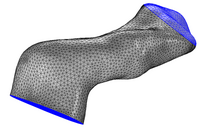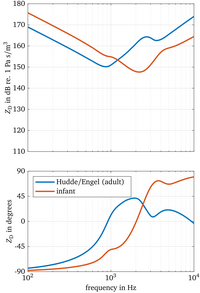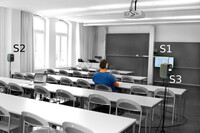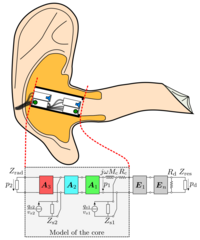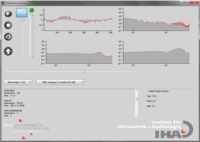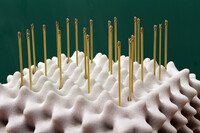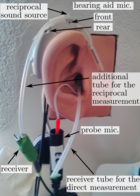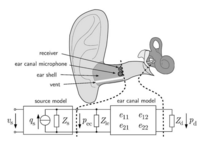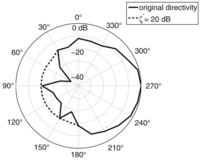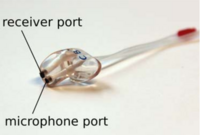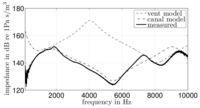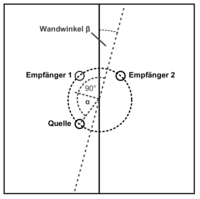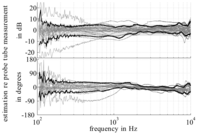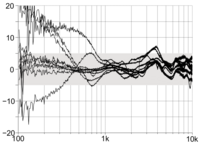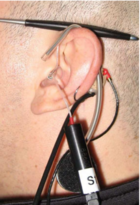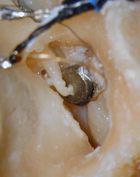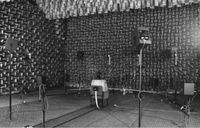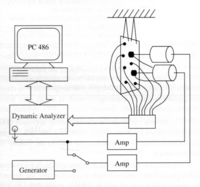Publications
A commented list of selected publications I consider particularly interesting.
A more complete list of my publications can be found here.
Wulbusch, N., Roden, R., Chernov, A., & Blau, M. (2023): Using a one-dimensional finite-element approximation of Webster’s horn equation to estimate individual ear canal acoustic transfer from input impedances. J. Acoust. Soc. Am. 153(5), 2826-2837. https://doi.org/10.1121/10.0019378
An elegant way of predicting the sound pressure generated by in-ear hearing systems at the individual eardrum is to combine an estimation of the source volume velocity with an estimation of the individual ear canal transfer impedance. Both can in turn be derived from one transfer function measurement with the in-ear system inserted into the individual wearer's ear. Here, we address the question of estimating the acoustic transfer impedance of individual ear canals. This is done by adjusting a horn (i.e., a duct with varying cross section along its axis) terminated by an eardrum model, such that its acoustic input impedance (magnitude and phase) is close to the one given as input data. The method is validated by three-dimensional finite element simulations of ear canals from our database available at doi.org/10.5281/zenodo.5528766.
Matlab code of the method available at https://github.com/nickwulbusch/earcanal-parameter-fitting-1d .
Sankowsky-Rothe, T., van de Par, S., & Blau, M. (2022, 2023). Parametric model of infants’ eardrum and ear canal impedances supporting immittance measurement results. Part I: Development of the model. Acta Acustica 6: 53 https://doi.org/10.1051/aacus/2022047 Part II: Prediction of eardrum and ear canal impedances for frequent pathological middle ear conditions. Acta Acustica 7: 21 https://doi.org/10.1051/aacus/2023017
Wideband Acoustic Immittance (WAI) measurement methods have been around for some time now, but in particular for young infants it is still difficult to infer precise information regarding the middle-ear status from them. In order to better understand middle-ear properties of young infants and their relation to WAI data, we propose an acousto-mechanical model of the middle ear of young infants in the first part (2022). The model predicts a markedly different eardrum impedance in comparison to adults. Matlab code available at https://github.com/tobiassankowsky/acoustic_impedance_infant_ear.
In the second part (2023), the model is extended to reflect two frequent pathological conditions, namely fluid and negative pressure in the tympanic cavity.
Roden, R., & Blau, M. (2021). The IHA database of human geometries including torso, head and complete outer ears for acoustic research.
doi.org/10.5281/zenodo.5528766
Our database of three-dimensional human anatomies (torso, head and complete outer ears) is available on Zenodo. In contrast to similar data sets, complete ear canals up to the eardrums are included, making it an ideal tool to study the interaction with in-ear hearing systems. We hope to add more subjects over the next years, so stay tuned!
Blau, M., Budnik, A., Fallahi, M., Steffens, H., Ewert, S.D., & van de Par, S. (2021). Toward realistic binaural auralizations - perceptual comparison between the auralized and the real room for a classroom scenario. Acta Acustica 5, 8.
How close to reality can one come with the binaural auralization of loudspeaker presentations in a classroom?
In this study, we evaluate a (head tracked) binaurally presented scene with respect to the original scene, presented over loudspeakers in a typical lecture room, using female speech as stimulus. Everything took place in the real room, i.e. all remaining cues such as visual ones were preserved naturally. It turned out that binaural presentations were almost undistinguishable from loudspeaker presentations. This was not only true for binaural renderings based on measured binaural room impulse responses (BRIRs) but for ones based on simulated BRIRs as well. Interestingly, the use of individual head-related impulse responses (HRIRs) in the simulations did not improve the perceptual ratings over the use of head-and-torso-simulator HRIRs.
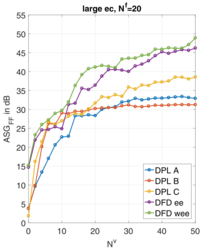
Sankowsky-Rothe, T., Schepker, H., Doclo, S., & Blau, M. (2020). Acoustic feedback path modeling for hearing aids: Comparison of physical position based and position independent models. The Journal of the Acoustical Society of America, 147(1), 85–100. https://doi.org/10.1121/10.0000509
Open hearing systems suffer from an increased risk of acoustic feedback – here we pick up the idea of splitting the feedback path models into two parts: a fixed, highly individual one and a time-variant one. It is shown for various variants that this is indeed a smart idea.
Vogl, S., & Blau, M. (2019). Individualized prediction of the sound pressure at the eardrum for an earpiece with integrated receivers and microphones. The Journal of the Acoustical Society of America, 145(2), 917–930. https://doi.org/10.1121/1.5089219
Individualized prediction of the sound pressure at the eardrum again, this time for a hearable-like earpiece with two receivers and two microphones.
Initially, we thought we could apply the methods we have developed for hearing aids over the last years without big modifications. However, the more lateral position of the earpiece and the presence of microphones and receivers in the vent forced us to reconsider these methods. The best method now features a four-slice ear canal model and is obtained by minimizing a cost function that incorporates both the amplitude and the phase of the acoustic input impedance of the individual ear canal in the frequency band from 1.2kHz to 10kHz.
Jaeger, H., Bitzer, J., Simmer, U., & Blau, M. (2017). Echtzeitfähiges binaurales Rendering mit Bewegungssensoren von 3D-Brillen. Fortschritte der Akustik - DAGA 2017, Kiel.
This is at the heart of our dynamical binaural renderer – a time-variant partitioned convolution engine, freely available for a variety of platforms at our github repository.
Rasumow, E., Hansen, M., Par, S. van de, Puschel, D., Mellert, V., Doclo, S., & Blau, M. (2016). Regularization Approaches for Synthesizing HRTF Directivity Patterns. IEEE/ACM Transactions on Audio, Speech, and Language Processing, 24(2), 215–225. https://doi.org/10.1109/TASLP.2015.2504874
Regularization strategies for our virtual artificial head (VAH). Among other measures, it is proposed to use the white noise gain averaged over all directions (WNGm) to control regularization.
Sankowsky-Rothe, T., Blau, M., Schepker, H., & Doclo, S. (2015). Reciprocal measurement of acoustic feedback paths in hearing aids. The Journal of the Acoustical Society of America, 138(4), EL399–EL404. https://doi.org/10.1121/1.4933062
Can reciprocity help make better feedback path measurements in vivo?
The idea is that by exploiting the principle of reciprocity, senders and receivers could be exchanged in the measurement of acoustic feedback paths in hearing aids. This permits to use much larger excitation levels in vivo, as the source is moved from the ear canal to a position outside the ear. In fact, it was shown that by this method, sound pressure levels in the ear canal can be reduced by 30..40dB. A good agreement between directly and reciprocally measured feedback paths was obtained in the frequency band from 400Hz..4kHz.
Sankowsky-Rothe, T., Blau, M., Köhler, S., & Stirnemann, A. (2015). Individual Equalization of Hearing Aids with Integrated Ear Canal Microphones. Acta Acustica united with Acustica, 101(3), 552–566. https://doi.org/10.3813/AAA.918852
What if a hearing aid was equipped wit an ear canal microphone?
This opens te possibility to integrate the methods we have developed to derive ear canal / eardrum / vent models into commercial hearing aids.
Rasumow, E., Blau, M., Hansen, M., van de Par, S., Doclo, S., Mellert, V., & Püschel, D. (2014). Smoothing individual head-related transfer functions in the frequency and spatial domains. The Journal of the Acoustical Society of America, 135(4), 2012–2025. https://doi.org/10.1121/1.4867372
To which extent can measured HRTFs be smoothed both in the frequency domain and spatially without causing audible effects?
Blau, M., Sankowsky-Rothe, T., Köhler, S., & Schmidt, J.-H. (2013). Using inter-individual standard deviation of hearing thresholds as a criterion to compare methods aimed at quantifying the acoustic input to the human auditory system in occluded ear scenarios. Proceedings of Meetings on Acoustics 19(1):030097 https://doi.org/10.1121/1.4801024
How can quantities aimed at specifying the acoustic input to the auditory system be validated?
Sankowsky-Rothe, T., Blau, M., Mojallal, H., Teschner, M., & Thiele, C. (2012). Prediction of the sound pressure at the ear drum for open fittings. Proc. Acoustics 2012, Nantes (France), 3919–3924. https://hal.archives-ouvertes.fr/hal-00810690/
Finally, we extended our individual ear canal and drum models to vented hearing systems. It is noteworthy that vents not only influence the low frequency band but also the high frequencies, due to wave effects in the vent.
Kaletta, M., & Blau, M. (2012). Modeling boundaries in acoustic TLM - local reflection coefficients vs. locally reacting impedances. Fortschritte der Akustik - DAGA 2012, Darmstadt.
Is specifying a local impedance node any better than a constant reflection coefficient in TLM? The short answer is no.
Sankowsky-Rothe, T., Blau, M., Rasumow, E., Mojallal, H., Teschner, M., & Thiele, C. (2011). Prediction of the Sound Pressure at the Ear Drum in Occluded Human Ears. Acta Acustica united with Acustica, 97(4), 656–668. https://doi.org/10.3813/AAA.918445
One (justified) point of criticism regarding our previous study was that it was using cadaver ears. Hence, we repeated it with live human subjects – with convincing results!
Blau, M., Sankowsky, T., Roeske, P., Mojallal, H., Teschner, M., & Thiele, C. (2010). Prediction of the sound pressure at the ear drum in occluded human cadaver ears. Acta Acustica united with Acustica, 96(3), 554–566. https://doi.org/10.3813/AAA.918306
Can the individual eardrum pressure be predicted on the basis of the measured acoustic impedance at the entrance to the residual ear canal?
This is our first study on the prediction of the individual eardrum pressure. In this study, we used human cadaver ears. Also includes an optimized version of the impedance measurement system originally proposed by Stirnemann et al., with neat features such as almost-immunity to near-field effects (later termed „evanescent components“ by others).
Blau, M., Sankowsky, T., Stirnemann, A., Oberdanner, H., & Schmitt, N. (2008). Acoustics of open fittings. Proceedings of Acoustics’08, Paris (France). https://doi.org/10.1121/1.2932603
Acoustic properties of various types of open hearing aid fittings, measured on 20 subjects.
Blau, M., Sankowsky, T., Oberdanner, H., & Stirnemann, A. (2008). Einfluss des Otoplastikprofils auf den objektiven Okklusionseffekt. Fortschritte der Akustik - DAGA 2008, Dresden.
The usual (passive) countermeasure to fight the occlusion effect is a vented earpiece. Can the same effect also be obtained with carefully chosen earmold surface profiles?
Yes, by using a surface coating that seals the leak between earmold and ear canal wall at the innermost position. Unfortunately, this is not the most comfortable desing...
Blau, M., Bornitz, M., Zahnert, T., Hofmann, G., & Hüttenbrink, K.-B. Implantable converter for cochlear implants and implantable hearing aids. US Patent 7,481,761 https://patents.google.com/patent/US7481761?oq=patent:7481761
An implantable microphone sitting in the incudo-stapedial joint, thereby exploiting the natural sound receiving system and avoiding irreversible surgical modification of the ossicular chain.
Blau, M. (2004). Correlation of Apparent Source Width with Objective Measures in Synthetic Sound Fields. Acta Acustica united with Acustica, 90(4), 720–730.
www.ingentaconnect.com/content/dav/aaua/2004/00000090/00000004/art00015
How can Apparent Source Width be predicted objectively?
Features a modified version of Trautmann's RL, termed RLE. See also the related paper
Blau, M. (2002). Difference limens for measures of apparent source width. Proc. Forum Acusticum, Sevilla, Spain.
www.conforg.fr/acoustics2008/cdrom/data/fa2002-sevilla/forumacusticum/archivos/rba02006.pdf
Blau, M. (1999). Indirect measurement of multiple excitation force spectra by frf matrix inversion: Influence of errors in statistical estimates of frfs and response spectra. Acta Acustica united with Acustica, 85(4), 464–479. https://www.ingentaconnect.com/content/dav/aaua/1999/00000085/00000004/art00004
This summarizes the main findings of my Dr.-Ing. dissertation on inverse methods to determine multiple excitation force spectra in mechanical systems. The focus is on models to predict confidence intervals for the resulting force spectra.

